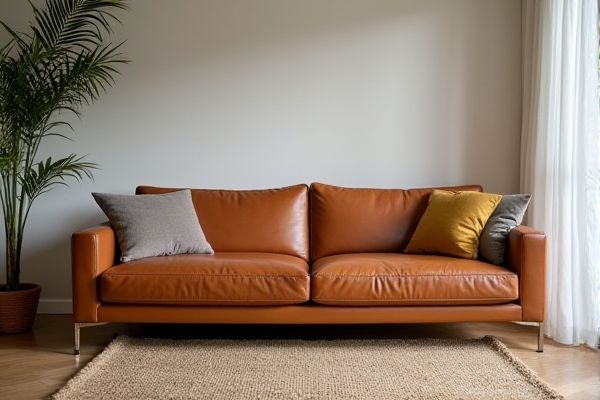
Leather sofas offer durability, easy maintenance, and a sleek, timeless appearance, while fabric sofas provide greater variety in colors and patterns, along with enhanced comfort and warmth. Discover which option aligns best with Your lifestyle and home decor by reading the rest of the article.
Table of Comparison
| Feature | Leather Sofa | Fabric Sofa |
|---|---|---|
| Material | Genuine or synthetic leather | Woven textiles like cotton, linen, polyester |
| Durability | High; resistant to wear and tear | Moderate; prone to stains and fading |
| Comfort | Firm, cool surface | Soft, breathable, and warm |
| Maintenance | Easy; wipe clean with a damp cloth | Requires regular vacuuming and spot cleaning |
| Allergy-friendly | Hypoallergenic; resists dust mites | Can harbor dust mites and allergens |
| Cost | Higher initial investment | Generally more affordable |
| Appearance | Luxurious, sleek, timeless | Varied textures and patterns |
| Temperature Sensitivity | Can feel cold in winter, sticky in summer | Consistently comfortable temperature |
Introduction: Leather Sofa vs Fabric Sofa
Leather sofas offer durability, easy maintenance, and a sleek, luxurious appearance, making them ideal for high-traffic living rooms and homes with pets. Fabric sofas provide greater variety in color, texture, and patterns, enhancing comfort and warmth while often being more budget-friendly. Choosing between leather and fabric depends on lifestyle needs, aesthetic preferences, and maintenance willingness.
Material Composition and Durability
Leather sofas feature animal hide treated through tanning, offering a sturdy, wear-resistant surface that ages with unique patina, making them highly durable and easy to clean. Fabric sofas utilize woven textiles such as cotton, polyester, or linen, providing diverse patterns and softness but requiring more maintenance and showing wear faster under frequent use. Your choice depends on balancing the long-lasting strength and sleek appeal of leather against the comfort and versatility of fabric upholstery.
Comfort and Feel
Leather sofas offer a smooth, cool surface that becomes softer and more supple over time, providing a luxurious and durable seating experience. Fabric sofas tend to feel warmer and cozier, with a variety of textures and weaves that enhance comfort and softness, ideal for extended lounging. Both materials provide unique tactile sensations, with leather favoring sleek elegance and fabric emphasizing plush warmth.
Style and Aesthetic Appeal
Leather sofas offer a sleek, luxurious look that adds sophistication and timeless elegance to any living space, making them ideal for modern and classic interiors alike. Fabric sofas provide versatility with a wide range of colors, patterns, and textures, allowing you to personalize your room's style and create a cozy, inviting atmosphere. Your choice between leather and fabric will significantly influence the overall aesthetic, whether you prefer a polished, high-end appearance or a warm, casual vibe.
Maintenance and Cleaning
Leather sofas require regular wiping with a damp cloth and occasional conditioning to maintain their durability and luster, while fabric sofas often need vacuuming and spot cleaning with upholstery cleaner to prevent stains and dust buildup. You should be aware that leather is more resistant to spills and stains but can crack without proper care, whereas fabric can offer more comfort but may harbor allergens if not cleaned frequently. Choosing between leather and fabric ultimately depends on your maintenance commitment and lifestyle preferences.
Allergy Considerations
Leather sofas are hypoallergenic and resistant to dust mites, pet dander, and other allergens, making them an excellent choice for allergy sufferers. Fabric sofas tend to absorb allergens and require more frequent cleaning to maintain a healthy environment. Choosing a leather sofa can help reduce allergen buildup and improve Your indoor air quality.
Cost Comparison
Leather sofas typically have a higher upfront cost, ranging from $1,000 to $5,000 depending on quality and brand, whereas fabric sofas generally cost between $300 and $2,000. Over time, leather sofas may require less frequent replacement due to their durability, potentially offering better long-term value despite initial investment. Fabric sofas often incur additional expenses for cleaning and maintenance, which can increase overall cost.
Environmental Impact
Leather sofas have a higher environmental impact due to the intensive resource use and pollution associated with cattle farming and tanning processes, which emit significant greenhouse gases and involve toxic chemicals. Fabric sofas, especially those made from natural or recycled materials, generally offer a lower carbon footprint as they rely less on animal agriculture and can use more sustainable fibers. Selecting sofas with eco-friendly certifications or using recycled upholstery can substantially reduce environmental harm regardless of material choice.
Suitability for Pets and Children
Leather sofas offer superior durability and easy cleaning, making them highly suitable for homes with pets and children prone to spills and scratches. Fabric sofas provide greater comfort and warmth but may absorb stains and require frequent maintenance, posing challenges in high-activity environments. Choosing between leather and fabric depends on balancing durability, maintenance, and comfort needs in households with pets and children.
Final Verdict: Choosing the Best Sofa for Your Home
Leather sofas offer durability and easy maintenance, making them ideal for homes with pets or children, while fabric sofas provide greater comfort and a wider range of colors and patterns, suiting those who prioritize coziness and design flexibility. Budget-wise, fabric sofas tend to be more affordable than genuine leather options, but high-quality leather sofas can last longer, potentially offering better long-term value. Assessing lifestyle, aesthetic preferences, and maintenance willingness helps determine the best sofa type to enhance both functionality and decor in your living space.
 homyna.com
homyna.com